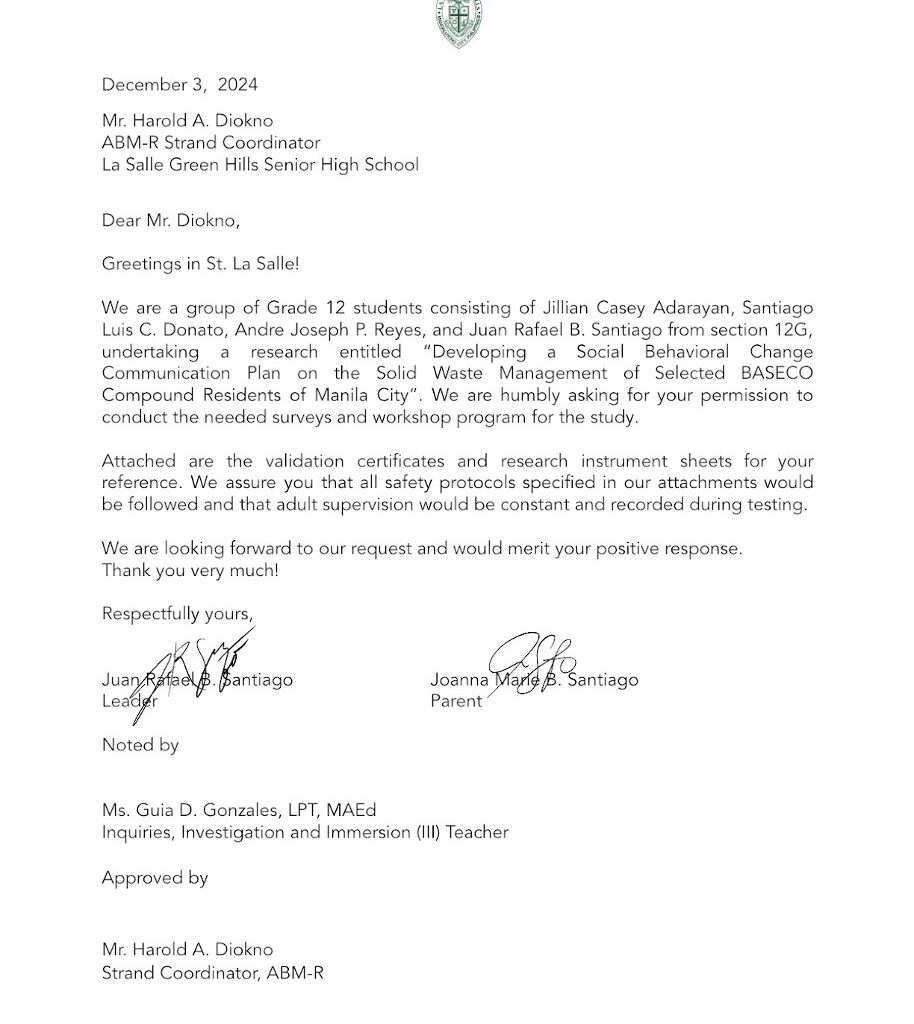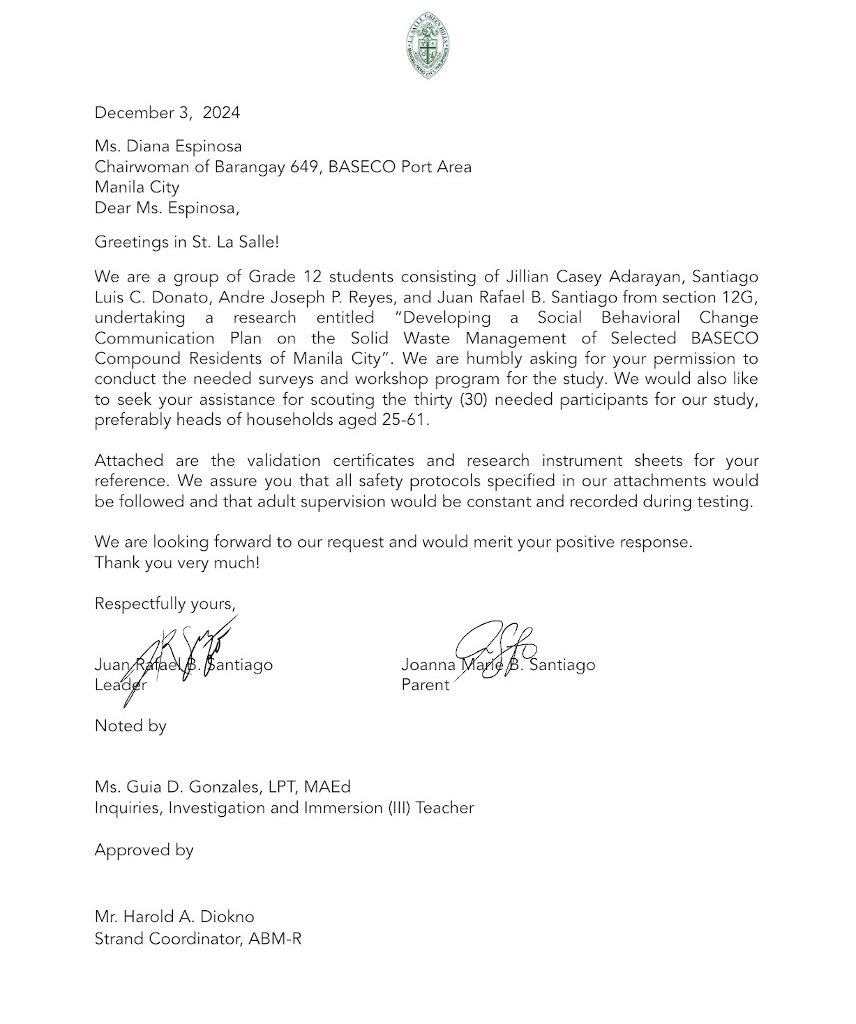DISCUSSION
This study is aimed at analyzing the effect of a Social Behavioral Change Communication plan on the level of intention of selected BASECO residents towards proper solid waste management using the Theory of Planned Behavior (Ajzen, 1991) through analyzing their personal attitudes, subjective norms, and perceived behavioral control on solid waste management. The communication plan contained a worksop program consisting of activities each catered towards the theoretical values.
With the conducted intervention, the activities served as the mediums of communication aimed to facilitate social and behavioral change towards proper solid waste management. While the infographic brochure was not implemented due to time constraints, the workshop still served to be effective in initiating change regardless of the pre-existing high awareness levels before the intervention as displayed by the significant increase in the mean scores.
The keynote talk given by the DENR representative served as an aid in providing knowledge to the participants regarding the current environmental situation in their community, as well as the significance of proper solid waste management and the necessity of solutions in the form of interventions such as the workshop being conducted on the day. The brief discussion was vital in strengthening their personal attitudes towards their responsibility in environmental action, which resulted in the mean increase of 3.53 to 3.87 post-intervention.
The community planning in which the participants gathered to discuss vulnerable areas and challenges faced by BASECO highlighted the importance of community participation in providing solutions. Through collective planning, their understanding of the influence of social norms in solid waste management was deepened, which was evident in the mean scores rising from 3.25 towards 3.67.
The segregation game in which participants had to categorize cutout pictures of common waste items in the area under the classifications given by RA 9003 (Ecological Solid Waste Management Act of 2000) helped in raising their awareness towards existing laws and regulations, as well as their confidence in properly following them. The activity helped in mobilizing perceived behavioral control, raising the mean score from 3.47 to 3.66 in the post-test.
The pledge between residents that was carried out contained their promises of acting towards solid waste management, highlighting their general intentions to act as a part of the solution within their community.
Overall, the activities were able to push for Social Behavioral Change among participants, displaying how effective communication and interactive forms of information dissemination serves as a crucial step in promoting long-term changes within the community.
Conclusion
The study explored how the implementation of a Social Behavioral Change Communication plan affects the level of intention of selected BASECO residents towards solid waste management through Icek Ajzen’s Theory of Planned Behavior. The locals’ level of intention pre and post-intervention could be described as strong upon assessment of personal attitudes, subjective norms, and perceived behavioral control. Results show that there is a significant difference among the level of intention in terms of personal attitudes, subjective norms, and perceived behavioral control before and after the communication plan was carried out, displaying an increase in the participants’ level of intention from the pre-test to the post-test. Findings highlight the significance of communication strategies and interactive workshop activities in mobilizing solid waste management.
Recommendations
The researchers recommend the implementation of communication plans in communities that face similar challenges in terms of solid waste management. Communication plans may be utilized as information dissemination and education strategies to push for certain agendas depending on the context. Additionally, future interventions may explore the implementation of infographics and other visual aids as part of the communication plans in pursuit of maintaining long-term impact, serving as supplementary aids for interactive workshops.
Future research may also explore the intersection of resident demographics and intentions to delve deeper into the dynamics of demographic variables and individual behavior within the context of solid waste management and environmental action. Lastly, follow-up studies may be conducted to measure the long-term efficacy of conducted workshop activities.
REFERENCES
Abubakar, I. R., Al-Gehlani, W. A. G., Alrawaf, T. I., AlShammari, M. S., AlShihri, F. S., Dano, U. L., & Maniruzzaman, K. M. (2022). Environmental Sustainability Impacts of Solid Waste Management Practices in the Global South. International Journal of Environmental Research and Public Health, 19(19), 12717; https://doi.org/10.3390/ijerph191912717
Adefris, W., Damene, S., Satyal, P. (2023). Household practices and determinants of solid waste management in Addis Ababa city, Ethiopia. Humanities and Social Sciences Communications, 10 (516). https://doi.org/10.1057/s41599-023-01982-7
Adu-Asare, J. (2024). Behavioral Change Communication: A Catalyst For Effective Waste Management. Medium. https://medium.com/@JerryAduAsare/behavioral-change-communication-a-catalyst-for-effective-waste-management-5694997304a3
Alcayna, T., Bollettiono, V., Enriquez, K., & Vinck, P. (2018). Perceptions of Disaster Resilience and Preparedness in the Philippines. Harvard Humanitarian Initiative. https://hhi.harvard.edu/publications/perceptions-disaster-resilience-and-preparedness-philippines
Antonio, E. S., Katipunan, F. J. M., Lumangyao, J. G. B. & Versoza, R. C. (2024). Solid Waste Management awareness and practices in coastal communities. Davao Research Journal, 15(3), 60-77. https://doi.org/10.59120/drj.v15i3.247
Aprianto, M. C., Duha, T., Riduan, A., Sabir, M., & Yamtana, Y. (2023). The Effect of Waste Management Policies, Community Participation, and Waste Treatment Technology on Environmental Pollution Levels in West Java. West Science Interdisciplinary Studies, 1(12):1360-1370; http://dx.doi.org/10.58812/wsis.v1i12.481
Areeprasert, C., Buttanoo, C., Leeabai, N. Siripaiboon, C., Sujirapatpong, W., Takahashi, F., Taweengern, K., & Yimyam, D. (2023). The integrated study of effects of infographic design on waste separation behavior and the behavioral outcome implementation on waste composting. ScienceDirect, 169, 276-285. https://doi.org/10.1016/j.wasman.2023.07.019
Arias, C. & Trujillo, C. (2020). Perceived Consumer Effectiveness as A Trigger of Behavioral Spillover Effects: A path towards Recycling. Sustainability, 12(11), 4348; https://doi.org/10.3390/su12114348
Atkinson, L., Diepen, M. T., Dunlop, L., Price, L., Rushton, E. A. C., Stubbs, J. E., & Wood, L. (2021). The challenges and affordances of online participatory workshops in the context of young people’s everyday climate crisis activism: insights from facilitators. Children’s Geographies, 21(1) 137-146. https://doi.org/10.1080/14733285.2021.2007218
Bersabal, I., Burog, J. J. A., Esplanada, C. A. D., Gunday, G. A., Libao, D. A., Manalaysay, M. J., Ocampo, J. L. B., & Sayat, A. C. M. (2018). A Study on the Impact of Littering to Flooding in Barangay Lalayat, San Jose, Batangas. ResearchGate. http://dx.doi.org/10.13140/RG.2.2.32680.21761
Bevans, R. (2023). Guide to experimental design: Overview, steps, & examples. Scribbr. https://www.scribbr.com/methodology/experimental-design/
Bhandari, P. (2023). What Is Quantitative Research? | Definition, Uses & Methods. Scribbr. https://www.scribbr.com/methodology/quantitative-research/
Bhattacharjee, S. (2024). Navigating the Intersection of Climate Action, Clean Energy, and Poverty Eradication. https://www.un.org/en/un-chronicle/navigating-intersection-climate-action-clean-e nergy-and-poverty-eradication
Bosano, R. (2024). Blazing Heat of 2024 ignites Filipinos’ need for trees and green spaces. ABS-CBN News. https://news.abs-cbn.com/specials/heat-ignites-need-for-trees
Brookes, E. (2023). The Theory of planned Behavior: Behavioral intention. Simply Psychology. https://www.simplypsychology.org/theory-of-planned-behavior.html
Brotosusilo, A., Nabila, S. H., Negoro, H. A., & Utari, D. (2020). The Level of individual participation of community in implementing effective solid waste management policies. Global Journal of Environmental Science and Management, 6(3): 341-354. https://doi.org/10.22034/gjesm.2020.03.05
Castro, L. J. A., Monsada, A. M., & Cruz, K. D. (2021). Occurrence of microplastics in the sediments of Baseco Port area at Manila Bay, Philippines. IOP Conference Series Earth and Environmental Science, 958(1), 012009. https://doi.org/10.1088/1755-1315/958/1/012009
Catan, I. & Molina, R. A. (2021). Solid Waste Management Awareness and Practices among Senior High School Students in a State College in Zamboanga City, Philippines. Aquademia, 5(1), 2542-4874, ep21001; https://doi.org/10.21601/aquademia/9579
Clenaghan, E. (2024). The Wilcoxon Signed-Rank Test. https://www.technologynetworks.com/informatics/articles/the-wilcoxon-signed-rank-test-370384
Corales, N. C. T., Limon, M. R., Vallente, J. P. C. (2020). Solid waste management beliefs and practices in rural households towards sustainable development and pro-environmental citizenship. Global Journal of Environmental Science and Management. https://doi.org/10.22034/gjesm.2020.04.02
Dyussenbayev, A. (2017). The Main Periods of Human Life. Global Journal of HUMAN-SOCIAL SCIENCE: A Arts & Humanities – Psychology, 17(7). https://globaljournals.org/GJHSS_Volume17/6-The-Main-Periods.pdf?fbclid=IwZXh0bgNhZW0CMTEAAR0sjlOotFBhpkO9AbCDc8w3IK9Tu-U1xhl6GLMS2Th_ILWbes_9QNDJPgo_aem_K2tJj_mme3tCMz_tIXx-WQ
Ell, D. (2024). The Communication Plan. SaskCulture. https://www.saskculture.ca/programs/organizational-support/organizational-resources/communications/the-communication-plan
Ferreras, V. (2024). Lack of discipline in waste management poses challenge in MMDA’s zero waste plan. GMA News Online. https://www.gmanetwork.com/news/topstories/metro/926038/lack-of-discipline-in-waste-management-poses-challenge-in-mmda-s-zero-waste-plan/story/
Gitnb. (2024). The Impact of Typhoon Gaemi on Metro Manila. Green is the New Black. https://greenisthenewblack.com/typhoon-gaemi-july-2024/
Gonzaga, M. L. R., Wong, M. T. S., Blanco, A. C., & Principe, J. A. (2021). UTILIZATION OF SENTINEL-2 IMAGERY IN THE ESTIMATION OF PLASTICS AMONG FLOATING DEBRIS ALONG THE COAST OF MANILA BAY. the International Archives of the Photogrammetry, Remote Sensing and Spatial Information Sciences/International Archives of the Photogrammetry, Remote Sensing and Spatial Information Sciences, XLVI-4/W6-2021, 177–184. https://doi.org/10.5194/isprs-archives-xlvi-4-w6-2021-177-2021
Kalra, N. (2019). Community Participation and Waste Management. ResearchGate, 1, 560072; http://dx.doi.org/10.1007/978-981-13-7071-7
Nathanson, J. A. (2024). Solid-waste management | Definition, Methods, Importance, & Facts. Encyclopedia Britannica.
https://www.britannica.com/technology/solid-waste-management/Composting
National Oceanic and Atmospheric Administration. (2022). Common measure: Environmental actions. https://www.noaa.gov/office-education/noaa-education-council/monitoring-resources/common-measure-definitions/environmental-actions
Jacqmarcq, M. (2021). Environmental activism in the digital age. Flux International Relations Review, 11(1). https://doi.org/10.26443/firr.v11i1.52
Lankes, H. P., Macquarie, R., Soubeyran, É., & Stern, N. (2023). The Relationship between Climate Action and Poverty Reduction. The World Bank Research Observer, 39(1), 1–46. https://doi.org/10.1093/wbro/lkad011
Lasco. (2020). Climate Change and Long-Standing Environmental Problems in the Philippines. https://transactions.nast.ph/wp-content/uploads/2023/04/2020-Plenary-Paper-Lasco-RD.pdf
Mackay, C. M., Cristoffanini, F., Wright, J. D., Neufeld, S. D., Ogawa, H. F., & Schmitt, M. T. (2021). Connection to nature and environmental activism: Politicized environmental identity mediates a relationship between identification with nature and observed environmental activist behaviour. Current Research in Ecological and Social Psychology, 2, 100009. https://doi.org/10.1016/j.cresp.2021.100009
Manifold. (n.d.). 12.2 Pre-experimental and quasi-experimental design. https://manifold.open.umn.edu/read/scientific-inquiry-in-social-work/section/bb5fe330-8130-4189-b661-ea2330605e68
Mendoza, I.A.F., Gotangco Gonzales, C. . & Favis, A.M.T. Experience-based environmental education and significant life experiences that influence environmental action among Filipinos. Journal of Environmental Studies and Sciences (2024). https://doi.org/10.1007/s13412-024-00956-8
Moshi, F. V., Kibusi, S. M., & Fabian, F. (2018, September 27). The effectiveness of community-based continuous training on promoting positive behaviors towards birth preparedness, male involvement, and maternal services utilization among expecting couples in Rukwa, Tanzania: A theory of planned behavior quasi-experimental study. Journal of environmental and public health. https://www.ncbi.nlm.nih.gov/pmc/articles/PMC6180969/
Murphy, T. P. (2004). Minnesota Report Card on Environmental Literacy. https://www.lrl.mn.gov/docs/2009/other/090273.pdf
Navarra, N. (2016). Surmounting the Risk: Community Ties of BASECO Compound in Managing Risk. Journal in Urban and Regional Planning. https://journals.upd.edu.ph/index.php/SURP/article/download/6846/5936/
Neighbors, C., Foster, D. W., & Fossos, N. (2013). Peer influences on addiction. In Elsevier eBooks (pp. 323–331). https://doi.org/10.1016/b978-0-12-398336-7.00033-4
Nguyen, A. T., Nguyen, N., Phung, P., & Yên-Khanh. (2023). Residents’ waste management practices in a developing country: A social practice theory analysis. Environmental Challenges, 13, 100770. https://doi.org/10.1016/j.envc.2023.100770
Akamike, I., Ekwueme, C., Mbachu, C. Nwankpa, O., & Onwujekwe, O. (2024). Do male and female heads of households have different beliefs about gender equity among young people in Nigeria? Front. Sociol. 9:1354991.
https://doi.org/10.3389/fsoc.2024.1354991
Raji, K. (2024). 4 Biggest Environmental Issues in the Philippines in 2024. Earth.Org. https://earth.org/environmental-issues-in-the-philippines/
REL Southwest (n.d). Developing a Communication Plan. REL Southwest. https://ies.ed.gov/ncee/rel/regions/southwest/publications/pdf/5.2.10-comm-plan-508.pdf
Saikia, P. & Hazarika, S. (2024). Construction of Environmental Activism in the Digital Age: Challenges and Opportunities. In: Singh, P., Ao, B., Medhavi, D. (eds) Environmental Activism and Global Media. Springer Studies in Media and Political Communication. https://doi.org/10.1007/978-3-031-55408-7_8
Singh, A. (2023). Re: What is the minimum sample size for a quasi experment? ResearchGate. https://www.researchgate.net/post/What_is_the_minimum_sample_size_for_a_quasi_experment/64a65b1158b01225060dc7fb/citation/download.
Stockholm Environment Institute. (2019). Making space: how public participation shapes environmental decision-making. https://www.sei.org/wp-content/uploads/2019/01/making-space-how-public-participation-shapes-environmental-decision-making.pdf
Thomas, L. (2024). Quasi-experimental design: Definition, types & examples. Scribbr. https://www.scribbr.com/methodology/quasi-experimental-design/
Turney, S. (2023). Central Limit Theorem | Formula, Definition, Examples. https://www.scribbr.com/statistics/central-limit-theorem/#:~:text=The%20central%20limit%20theorem%20says,the%20mean%20will%20be%20normal.
University of Reading. (2020). Developing a Communications Plan for your Research. developing a communications plan for your researchUniversity of Readinghttps://www.reading.ac.uk › discover › files › pdfs
Valenzuela, V.P.B., Esteban, M. & Onuki, M. Perception of Disasters and Land Reclamation in an Informal Settlement on Reclaimed Land: Case of the BASECO Compound, Manila, the Philippines. Int J Disaster Risk Sci 11, 640–654 (2020). https://doi.org/10.1007/s13753-020-00300-y
Villanueva, G. & Corrales, N. (2024). PH still world’s most at-risk to disasters. Inquirer.Net. https://globalnation.inquirer.net/248995/ph-still-worlds-most-at-risk-to-disasters
Wolbring, G., & Gill, S. (2023). Potential Impact of Environmental activism: A survey and a scoping review. Sustainability, 15(4), 2962. https://doi.org/10.3390/su15042962
World Vision. (2023). Safe and Prosperous BASECO. https://www.worldvision.org.ph/wp-content/uploads/2023/08/Safe-and-Prosperous-BASECO.pdf
Zhuang, T. (2024). Resolving Conflict Emotions: Strategies for Enhancing Environmental Communication and Public Engagement on Social Media from a Communication Semiotics Perspective — A Case Study of the Red Platform. Jurnal Audiens, 5(2). https://doi.org/10.18196/jas.v5i2.475
APPENDIX A:
Invitation Letters to ABM-R Strand Coordinator and Barangay Captain



